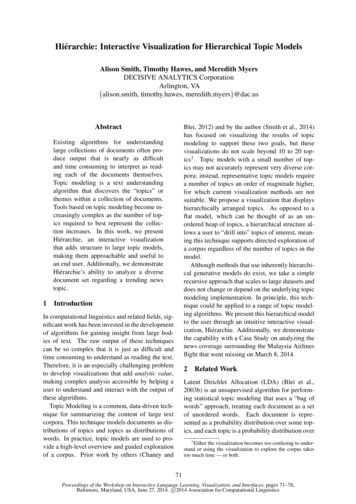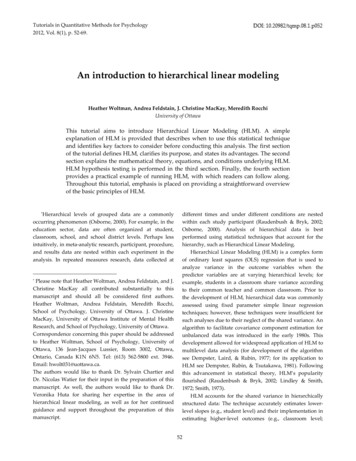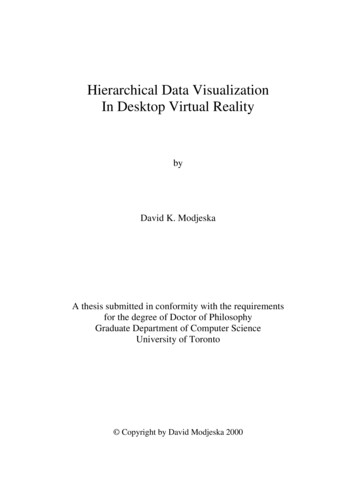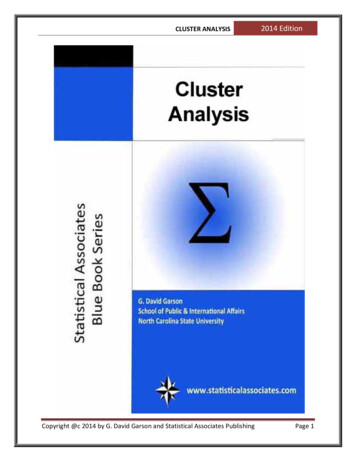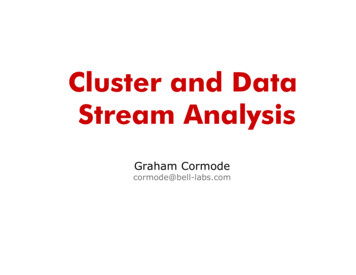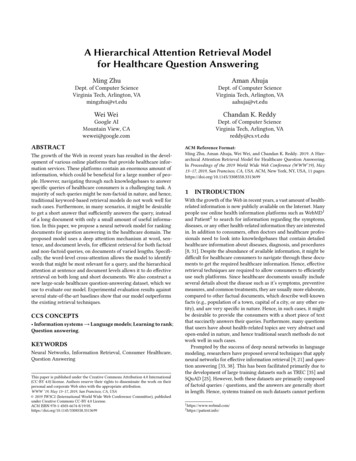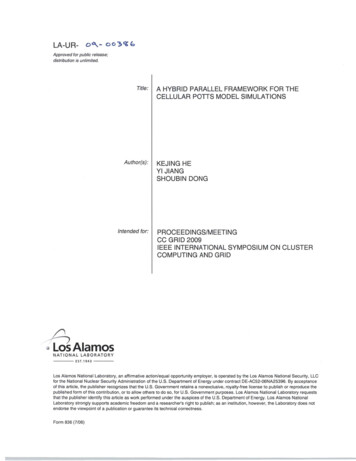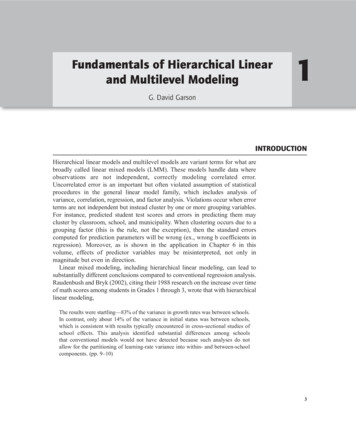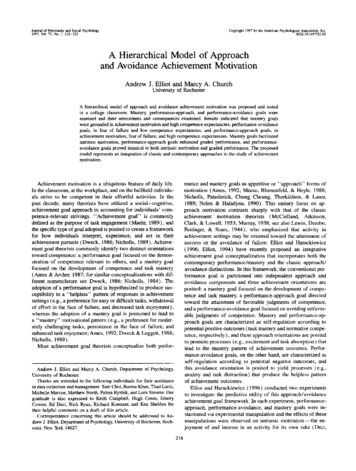
Transcription
Journal of Personality and Social Psychology1997, Vol. 72, No. 1,218-232Copyright 1997 by the American Psychological Association, Inc.0022-3514/97/ 3.00A Hierarchical Model of Approachand Avoidance Achievement MotivationAndrew J. Elliot and Marcy A. ChurchUniversity of RochesterA hierarchical model of approach and avoidance achievementmotivation was proposed and testedin a college classroom. Mastery, performance-approach, and performance-avoidance goals wereassessed and their antecedents and consequences examined. Results indicated that mastery goalswere grounded in achievementmotivationand high competenceexpectancies;performance-avoidancegoals, in fear of failure and low competence expectancies; and performance-approach goals, inach.ievementmotivation,fear of failure, and high competenceexpectancies. Mastery goals facilitatedintrinsic motivation,performance-approach goals enhanced graded performance, and performanceavoidance goals proved inimical to both intrinsic motivationand graded performance. The proposedmodel represents an integration of classic and contemporary approaches to the study of achievementmotivation.Achievement motivation is a ubiquitous feature of daily life.In the classroom, at the workplace, and on the ballfield individuals strive to be competent in their effortful activities. In thepast decade, many theorists have utilized a social-cognitive,achievement goal approach in accounting for individuals' competence-relevant strivings. "Achievement goal" is commonlydefined as the purpose of task engagement (Maehr, 1989), andthe specific type of goal adopted is posited to create a frameworkfor how individuals interpret, experience, and act in theirachievement pursuits (Dweck, 1986; Nicholls, 1989). Achievement goal theorists commonly identify two distinct orientationstoward competence: a performance goal focused on the demonstration of competence relevant to others, and a mastery goalfocused on the development of competence and task mastery(Ames & Archer, 1987; for similar conceptualizations with different nomenclature see Dweck, 1986; NichoUs, 1984). Theadoption of a performance goal is hypothesized to produce susceptibility to a "helpless" pattern of responses in achievementsettings (e.g., a preference for easy or difficult tasks, withdrawalof effort in the face of failure, and decreased task enjoyment),whereas the adoption of a mastery goal is presumed to lead toa "mastery" motivational pattern (e.g., a preference for moderately challenging tasks, persistence in the face of failure, andenhanced task enjoyment; Ames, 1992; Dweck & Leggett, 1988;Nicholls, 1989).Most achievement goal theorists conceptualize both perfor-mance and mastery goals as appetitive or "approach" forms ofmotivation (Ames, 1992; Meece, Blumenfeld, & Hoyle, 1988;Nicholls, Patashnick, Chung Cheung, Thorkildsen, & Lauer,1989; Nolen & Haladyna, 1990). This unitary focus on approach motivation contrasts sharply with that of the classicachievement motivation theorists (McClelland, Atkinson,Clark, & Lowell, 1953; Murray, 1938; see also Lewin, Dembo,Festinger, & Sears, 1944), who emphasized that activity inachievement settings may be oriented toward the attainment ofsuccess or the avoidance of failure. Elliot and Harackiewicz(1996; Elliot, 1994) have recently proposed an integrativeachievement goal conceptualization that incorporates both thecontemporary performance/mastery and the classic approach/avoidance distinctions. In this framework, the conventional performance goal is partitioned into independent approach andavoidance components and three achievement orientations areposited: a mastery goal focused on the development of competence and task mastery, a performance-approach goal directedtoward the attainment of favorable judgments of competence,and a performance-avoidance goal focused on avoiding unfavorable judgments of competence. Mastery and performance-approach goals are characterized as self-regulation according topotential positive outcomes (task mastery and normative competence, respectively), and these approach orientations are positedto promote processes (e.g., excitement and task absorption) thatlead to the mastery pattern of achievement outcomes. Performance-avoidance goals, on the other hand, are characterized asself-regulation according to potential negative outcomes, andthis avoidance orientation is posited to yield processes (e.g.,anxiety and task distraction) that produce the helpless patternof achievement outcomes.Elliot and Harackiewicz (1996) conducted two experimentsto investigate the predictive utility of this approach/avoidanceachievement goal framework. In each experiment, performanceapproach, performance-avoidance, and mastery goals were instantiated via experimental manipulation and the effects of thesemanipulations were observed on intrinsic motivation--the enjoyment of and interest in an activity for its own sake (Deci,Andrew J. Elliot and Marcy A. Church, Department of Psychology,Universityof Rochester.Thanks are extended to the following individualsfor their assistancein data collection and management:Sam Choi, Reema Khan, Thad Lurie,Michelle Mareoe, Matthew North, Polina Ryzhik, and Lore Stevens. Ourgratitude is also expressed to Keith Campbell, Hugh Crean, EmoryCowen, Ed Deci, Rich Ryan, Richard Koestner, and Ken Sheldon fortheir helpful comments on a draft of this article.Correspondence concerning this article should be addressed to Andrew J. Elliot, Departmentof Psychology,Universityof Rochester, Rochester, New York 14627.218
APPROACH AND AVOIDANCE1975; Lepper, 1981; Ryan, 1993). Results from the two experiments provided support for the proposed conceptualization. Performance-avoidance goals undermined intrinsic motivation relative to both mastery and performance-approach goals; the latterorientations manifested equivalent levels of intrinsic motivation.In the present research, we emerged from the experimentallaboratory and entered the college classroom to measure, ratherthan manipulate, the three achievement goal orientations. Thismethodological shift not only enabled us to explore the generalizability of the experimental findings to a naturalistic achievement setting, but also afforded us a direct test of the validity ofthe proposed trichotomous framework (particularly the partitioning of the performance goal into independent approach andavoidance components). Specifically, we created a series ofitems to assess students' goals for their personality psychologyclass and used factor analytic procedures to examine whether theitems indeed separated into independent performance-approach,performance-avoidance, and mastery goal orientations. In addition, we sought to further extend the work of Elliot and Harackiewicz on a number of fronts. First, we investigated the personality and expectancy-based antecedents of achievement goal adoption. Second, we explored the consequences of achievement goaladoption for actual performance as well as intrinsic motivation.Third, we moved to differentiate the two approach forms ofmotivation by positing a divergent pattern of antecedents and adifferent set of consequences for the mastery and performanceapproach goal orientations. We pursued each of these objectivesin the process of proposing and testing a hierarchical model ofapproach and avoidance achievement motivation.A Hierarchical M o d e l o f A p p r o a c h and AvoidanceAchievement MotivationSince McDougal (1908, 1932) linked "desired goals" to"preferences" (initially "instincts"), personality theoristshave proposed hierarchical models of motivation in which goalsor goal concepts (Pervin, 1989) are portrayed as concrete representations of more abstract motivational dispositions (Cattell,1957; Emmons, 1989; McClelland, 1951; Murray, 1938; Nuttin,1984; Rotter, 1954). In this general tradition, goal conceptsare conceptualized as midlevel constructs, structurally situatedbetween global motivational dispositions and specific behaviors.Goal concepts are commonly perceived as the proximal regulators of behavior, and motivational dispositions are viewed asexerting a primarily distal, indirect influence via their moreconcrete manifestations (see also Carver & Scheier, 1981; Powers, 1973; and other cybernetic conceptualizations).Our model fits nicely into this tradition, in that we viewachievement goals as cognitive-dynamic manifestations of twounderlying competence-relevant motives--the need for achievement and the need to avoid failure (Atldnson, 1957; Hoppe,1930, cited in Lewin et al., 1944; McClelland, 1951; Murray,1938). Whether construed as nonconscious (implicit) or conscious (self-attributed) needs, these motive dispositions are posited to energize, select, and direct achievement behavior(McClelland, Koestner, & Weinberger, 1989) through the channel of their concrete achievement goal representations. That is,the primary effect of achievement motivation and fear of failureon achievement outcomes is posited to be indirect; their midlevelmotivational surrogates--achievement g o a l s - - a r e presumed to219be the direct regulators and proximal determinants of achievement behavior. Thus, we view achievement goals as "focusedneeds" (Nuttin, 1984), concretized "servants" (Ryan, Sheldon, Kasser, & Deci, 1995) of their higher order achievementrelevant motives.Most achievement theorists also identify task-specific competence expectancies as an important variable in achievement settings (Atkinson, 1957; Bandura, 1982; Butler, 1992; Harter,1989; Weiner, 1972). Some theorists in the classic achievementmotivation tradition have even designated competence expectancies the "active ingredient" in achievement motivation and fearof failure and proposed that competence expectancies replacemotive dispositions as an explanatory construct (Kukla, 1972;Meyer, 1987). Those working out of the contemporary achievement goal perspective have tended to conceptualize competenceexpectancies as a moderator variable, interacting with achievement goals to produce achievement-relevant outcomes (Nicholls, 1983, 1984). In contrast to both of these conceptualizations, we view competence expectancies as empirically relatedto but conceptually distinct from motive dispositions (Heckhausen, Schmalt, & Schneider, 1985; for an extended discussionof this issue, see Elliot, 1994), and we believe that competenceexpectancies are best portrayed as antecedents of achievementgoals rather than as moderators of their effects. That is, weperceive the effect of competence expectancies on achievementrelevant outcomes to be relatively independent of motive dispositions, and we posit that competence expectancies, like motivedispositions, exert their primary influence on achievement behavior indirectly, via their effect on achievement goal adoption.Figure 1 presents a pictorial summary of the proposed hierarchical model, in which motive dispositions (achievement motivation and fear of failure) represent higher order motivationalconstructs, achievement goals (performance-approach, performance-avoidance, and mastery) represent midlevel "motivational surrogates," and task-specific competence expectanciesare conceptualized as an independent antecedent of achievementgoal adoption. Motive dispositions and competence expectanciesare posited to be direct antecedents of achievement goal adoption, and achievement goals are viewed as exerting a direct,proximal influence on achievement-relevant behavior. 1The proposed model does not preclude the possibility of direct effects of motive dispositions and competence expectancies on achievement-relevant behavior; such relationships are simply of peripheral interest. Of central interest are the relationships between (a) motive dispositions/competence expectancies and achievement goals, (b) achievementgoals and achievement-relevant behavior with the variance accountedfor by motive dispositions/competence expectancies controlled, and (c)motive dispositions/competence expectancies and achievement-relevantbehavior with the variance accounted for by achievement goals controlled. The first two relationships are posited to be significant and thelast null, thereby designating the relationship between motive dispositions/competence expectancies and achievement-relevant behavior to beindirect in nature regardless of the presence or absence of a direct effectbetween motive dispositions/competence expectancies and achievementrelevant behavior per se (see Darlington, 1990; Judd & Kenny, 1981;Pedhazur, 1982). In addition, the proposed model does not preclude thepossibility of a reciprocal relationship between competence expectanciesand achievement goals (Bandura, 1986). In the present research wefocused on testing competence expectancies as an antecedent of achievement goal adoption; the effect of achievement goal pursuit on ongoingcompetence expectancies awaits future research attention.
220ELLIOT ementrelevant outcomesCompetenceexpectanciesFigure 1.A hierarchical model of approach and avoidance achievementmotivation.The First Link in the Model: Antecedents ofAchievement GoalsIn the present research we assessed achievement motivation,fear of failure, and competence expectancies in addition to thethree achievement goals in order to test the first link in ourproposed model and to determine the distinct profiles underlyingeach goal type. Achievement motivation and fear of failure maybe defined simply as the generalized desire to succeed and thegeneralized desire to avoid failure, respectively (Atkinson,1957; for more elaborate definitions of these constructs, seeBirney, Burdick, & Teevan, 1969; McClelland, 1985). Achievement motivation orients individuals toward the possibility ofsuccess (McClelland et al., 1953), and, consequently, it is likelythat this motive disposition will prompt the adoption of selfregulatory forms focused on the attainment of positive outcomes--mastery and performance-approach goals. In reciprocal fashion, fear of failure orients individuals toward the possibility of failure (Birney et al., 1969) and therefore is likely toevoke performance-avoidance goals that focus on the avoidanceof negative outcomes.In addition to this straightforward outcome focus symmetry,we posit that approach achievement goals may also serve afailure avoidance function. A number of motivational theoristshave observed that the desire for avoidance at the genotypic orfunctional level can often lead to approach at the level of phenotypic behavioral expression (e.g., Gray's, 1987, concept of active avoidance; see also Birney et al., 1969; Depreeuw, 1992;McClelland et al., 1953), and it seems reasonable to anticipatea corresponding relationship between underlying motive dispositions and their concretized goal representations. That is, thegeneralized desire to avoid failure at the genotypic level mayprompt the adoption of a regulatory form focused on the attainment of positive outcomes (approach in order to avoid failure),as well as a regulatory form focused on the avoidance of negative outcomes. Although it is possible that either approach formof regulation could serve this failure-avoidance function, theperformance-approach goal seems the most viable candidate. Inmost achievement settings, the demonstration of normative ability clearly and directly mitigates any concerns about failure,whereas the development of competence and task mastery oftenentails a protracted process inclusive of failure experiences (thevery thing the person high in fear of failure is desperate toavoid). Therefore, in the proposed model, we view masteryand performance-avoidance goals as relatively "pure" formsof regulation in that they serve a single genotypic motivationalfunction (achievement motivation and fear of failure, respectively), whereas the performance-approach orientation is conceptualized as a more complex form of regulation in that it canserve both approach (achievement motivation) and avoidance(fear of failure) motivational functions at the genotypic level.Our predictions for competence expectancy were straightforward: Individuals who believed they could attain competencein an achievement situation would orient toward the possibilityof success and adopt approach achievement goals (mastery andperformance-approach), whereas individuals with low expectancies would orient toward the possibility of failure and adopta performance-avoidance goal. We expected achievement motivation, fear of failure, and competence expectancy to accountfor unique variance in the selection of achievement goals whentested via simultaneous multiple regression, thus identifying motive dispositions and competence expectancies as independentantecedents of achievement goal adoption.The Second Link in the Model: Consequences ofAchievement GoalsThe second link in our proposed path model represents therelationship between achievement goals and achievement-relevant outcomes. In the present study, we focused on two outcomevariables commonly considered central components of theachievement goal nomological network, intrinsic motivation (assessed via questionnaire near the end of the semester) and(graded) performance (Ames, 1992; Dweck & Leggett, 1988;Nicholls, 1989). Our predictions for performance-approach,performance-avoidance, and mastery goals were derived fromthree primary sources: the extant literature on achievement goalsin the classroom, 2 our aforementioned hypotheses regarding themotive dispositions and competence expectancies underlyingeach goal representation, and our beliefs about the processeslikely to be elicited by each form of regulation.' One of the clearest, most consistent patterns to emerge fromthe achievement goal literature is the positive relationship between mastery goals and intrinsic motivation (Ames & Archer,1988; Archer, 1994; Duda & Nicholls, 1992; Harackiewicz, Barron, Carter, Lehto, & Elliot, 1997; Miller, Behrens, Greene, &Newman, 1993; Nicholls, Patashnick, & Nolen, 1985). Masterygoals seem optimal for the facilitation of intrinsic motivation inthat they are presumably grounded in a fundamentally approachform of motivation (relatively "uncontaminated" by fear offailure; White, 1959) and are hypothesized to elicit processes,such as challenge appraisal, excitement, and task absorption, thatfoster interest and enjoyment (Elliot, 1994). The relationshipbetween mastery goals and graded performance, on the otherhand, is more difficult to discern from the extant literature.2 Some researchers have assessed achievement goals for a specificclass, whereas others have focused more generally on goal adoption inclassroom settings. The results have been similar in both instances, andtherefore we considered both types of studies in our review of theliterature.
APPROACH AND AVOIDANCEApproximately half of the existing studies document a positiverelationship, whereas the other half yield null effects (with nulleffects most frequent for university undergraduates; Harackiewicz et al., 1997; Kroll, 1988; Nicholls et al., 1985; Nolen &Haladyna, 1990; Pintrich, 1989; Pintrich & Garcia, 1991; Pintrich, Smith, Garcia, & Mckeachie, 1993). Mastery goals havebeen linked to a number of cognitive and metacognitive studystrategies presumed to enhance performance (Ames & Archer,1988; Meece et al., 1988; Nolen, 1988; Pintrich & De Groot,1990), but in the college classroom, where rigid multiple-choiceexaminations commonly prevail, the content of the materialstudied may be as important as the specific study strategy utilized. Mastery goals seem as likely to prompt the perusal ofinteresting but peripheral material as they are to induce intensivestudy of information central to course objectives; optimal processing of peripheral material is of little benefit at examinationtime. Thus, in the present study, we predicted that mastery goalswould display a positive relationship with intrinsic motivationbut would reveal no reliable pattern for graded performance.Measures of the performance goal orientation in the prevailingperformance/mastery goal tradition vary in composition; someconsist entirely of positively framed items (thereby assessing aperformance-approach goal), whereas others are an amalgamof positively and negatively framed items (thereby assessinga hybrid performance-approach/performance-avoidance goal).Studies in which negatively framed items are incorporated intoperformance goal assessments (the closest thing to a performance-avoidance goal in the extant literature) tend to yieldnegative or null relationships with intrinsic motivation andgraded performance (Ames & Archer, 1988; Duda & Nicholls,1992; Kroll, 1988; Miller et al., 1993; Nicholls et al., 1985;Nolen & Haladyna, 1990). Conceptually, performance-avoidance goals are presumed to be grounded in fear of failure andlow competence expectancies. As such, these forms of regulation are likely to elicit threat appraisals, evaluative anxiety, andvigilant attention to failure-relevant information (Elliot, 1994;Higgins, 1995; Wegner, 1994), processes that exude self-protection concerns and avoidance tendencies antithetical to the verynature of intrinsic motivation (Deci, 1975; White, 1959). Academic performance is also likely to be undermined by these andother self-protective and avoidance-based processes emanatingfrom fear of failure, such as strategic withdrawal of effort,self-handicapping, and procrastination (Covington & Omelich,1979; Rhodewalt, 1990; Rothblum, 1990). Therefore, in thepresent study we expected performance-avoidance goals to havea uniformly negative effect, undermining both intrinsic motivation and graded performance.Studies in which all of the items in the performance goalassessments are positively framed (i.e., performance-approachmeasures) tend to document null or positive relationships forintrinsic motivation and graded performance (Archer, 1994;Harackiewicz et al., 1997; Pintrich & Garcia, 1991; Pintrich etal., 1993). Performance-approach goals are presumably undergirded by both achievement motivation and fear of failure, andit is likely that intrinsic motivation would be facilitated byperformance-approach goal processes emanating from achievement motivation (e.g., challenge appraisal), whereas processesemerging out of fear of failure (e.g., threat appraisal) wouldlikely be deleterious to intrinsic motivation (Elliot, 1994). Giventhese antagonistic processes; in the present study we anticipated221the resultant effect of performance-approach goals on intrinsicmotivation to be null.A number of achievement theorists have portrayed fear offailure as an inhibitor of effort and performance when unaccompanied by achievement motivation but a facilitator of effort andperformance when accompanied by achievement motivation(Bimey et al., 1969; Covington & Roberts, 1995; Heckhausenet al., 1985). Given that performance-approach goals are presumably undergirded by fear of failure coupled with achievement motivation (as well as a high competence expectancy), itis likely that they would promote rigorous and persistent studybehavior that eventuates in high levels of achievement (see research on defensive pessimism, Norem & Cantor, 1986). Furthermore, like mastery goals, performance-approach goals (i.e.,those assessed with positively framed items) have been linkedto study strategies presumed to facilitate performance (Archer,1994; Meece et al., 1988; Pintrich & Garcia, 1991), and thefocus on normative outcomes inherent in this form of regulationshould keep study efforts channeled toward (testable) materialthat will yield performance dividends. Therefore, in the presentstudy we expected performance-approach goals to have a positive influence on graded performance.In sum, in the present research we proposed a hierarchicalmodel of approach and avoidance achievement motivation andtested this framework by assessing the hypothesized antecedents(motive dispositions and competence expectancies) and consequences (intrinsic motivation and graded performance) of mastery, performance-approach, and performance-avoidance goaladoption in the college classroom. In the model, mastery goalsare portrayed as grounded in achievement motivation and highcompetence expectancies, and are expected to facilitate intrinsicmotivation but to have no reliable effect on graded performance.Performance-avoidance goals are construed as grounded tin fearof failure and low competence expectancies, and are expectedto undermine both intrinsic motivation and graded performance.Performance-approach goals are perceived as grounded inachievement motivation, fear of failure, and high competenceexpectancies and are predicted to have a null effect on intrinsicmotivation but a positive effect on graded performance. Motivedispositions and competence expectancies are hypothesized toexert their influence on intrinsic motivation and graded performance indirectly, through their effect on achievement goals;null relationships are anticipated for these variables when theproximal effects of achievement goals are controlled.MethodParticipants and Achievement ContextA total of 204 (82 male and 122 female) undergraduates enrolled ina personality psychology course at the University of Rochester participated in the study in return for extra course credit. Most participantswere sophomores or juniors at the university, with a mean age of 20.01years for the sample. The class was conducted in an exclusively lectureformat; evaluation was based entirely on multiple-choice examinationsand a normative grading structure.ProcedureParticipants' achievement motivation, fear of failure, competence expectancies, achievement goals, competence perceptions, and intrinsic
222ELLIOT AND CHURCHmotivation were assessed in a series of sessions conducted over thecourse of the semester. All assessments took place immediately beforeclass, with the professor absent from the room. Participants were assuredthat their responses would remain confidential and would in no wayinfluence their course grade.The motive disposition and competence expectancy variables weremeasured during the first week of the semester. Achievement motivationand fear of failure were assessed in the first class session. Competenceexpectancies were assessed in the second session, conducted 3 dayslater. Achievement goals were assessed during the second week of thesemester and competence perceptions were measured t w i c e - - u p o n receipt of feedback after the first midterm examination and again uponreceipt of feedback after the second midterm examination. Intrinsicmotivation was assessed near the end of the semester. Final grades wereobtained from the professor at the end of the course; all participantsconsented to the release of their grade information.MeasuresAchievement motivation. We used the Achievement Motivation subscale of Jackson's (1974) Personality Research Form as the indicatorof the achievement motive (sample items are "I enjoy difficult work"and "I often set goals that are difficult to reach"). Murray's (1938)conceptualization of the need for achievement as a broad, unitary construct was used as a guide in developing the measure. A number ofempirical investigations have attested to the reliability and constructvalidity of the measure (Fineman, 1977; Fiske, 1973; Harper, 1975),and recent work has established its predictive validity in the collegeclassroom (achievement motivation scores have been linked to challengeappraisal, reported excitement, task involvement, positive outcome focus, and adaptive attributional propensities; Elliot & Church, 1995).Participants' responses on the 16 true-false items were summed to formthe achievement motivation index (Cronbach's alpha .76).Fear of failure. Herman's (1990) 27-item fear of failure measurewas used as the indicator of the fear of failure motive (sample itemsare "I try to avoid failure at all costs" and "I often avoid a task becauseI am afraid that I will make mistakes"). This scale was developed torepresent the various components of fear of failure identified by Atkinsonand Feather (1966) in their portrait of the "failure threatened personality." The newly revised version of the scale was used in the presentstudy; recent research (Elliot & Church, 1995) attests to its reliability(e.g., Cronbach's a .88) and construct validity. Correlates of themeasure include more general measures of avoidance (e.g., the Behavioral Inhibition subscale of the BIS/BAS questionnaire; Carver & White,1994), more specific measures of fear of failure in the classroom (e.g.,the avoidance subscale of the Approach Avoidance Achievement Questionnaire [AAAQ] ; Covington & Roberts, 1995 ), as well as other assessment tools used as indicators of fear of failure (e.g., the Test AnxietyInventory, Speilberger, Gonzalez, Taylor, Algaze, & Anton, 1978 ). Predictive validity in the college classroom has also been established: fearof failure scores have been linked to threat appraisal, reported anxiety,task distraction, negative outcome focus, and various self-protective attributional propensities (Elliot & Church, 1995 ). Participants' responseson the 5-point scale from strongly disagree (1) to strongly agree (5)were averaged to form the fear of failure index (Cronbach's .86).Competence expectancy. Two items assessed participants' expectations of competence: "I expect to do well in this class" and "I believeI will receive an excellent grade in this class." Participants used 1(strongly disagree) to 7 (strongly agree) scales to indicate their responses, which were averaged to form the competence expectancy index(Cronbach's t .82).Achievement goals. An achievement goal questionnaire was usedto assess participants' adoption of mastery, performance-approach, andperformance-avoidance achievement goals in their personality psychology class. A series of pilot studies were conducted in developing thequestionnaire in which item pools for each goal orientation were gener-ated, tested (v
the primary effect of achievement motivation and fear of failure on achievement outcomes is posited to be indirect; their midlevel motivational surrogates--achievement goals--are presumed to be the direct regulators and proximal determinants of achieve- ment behavior. Thus, we view achievement goals as "focused
